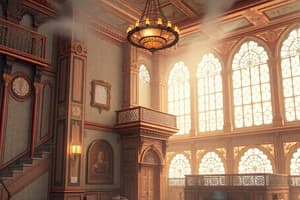Podcast
Questions and Answers
What are the ways an employer can protect workers from falls?
What are the ways an employer can protect workers from falls?
- Guardrails
- Safety net system
- Personal fall arrest systems
- All of the above (correct)
As a load is mechanically lifted, the materials _____________.
As a load is mechanically lifted, the materials _____________.
may strike workers if the load swings, twists or turns.
For workers on scaffolds, fall protection must be provided if they are working __________ above a lower level.
For workers on scaffolds, fall protection must be provided if they are working __________ above a lower level.
10'
A ladder must extend at least _____ above the work surface you are climbing onto.
A ladder must extend at least _____ above the work surface you are climbing onto.
What is the greatest hazard or risk for workers in excavating trenches?
What is the greatest hazard or risk for workers in excavating trenches?
It is the responsibility of the worker to wear the PPE provided to him.
It is the responsibility of the worker to wear the PPE provided to him.
In general, fall protection must be provided to construction workers who are working on surfaces with unprotected sides and edges which are _____ above the lower level.
In general, fall protection must be provided to construction workers who are working on surfaces with unprotected sides and edges which are _____ above the lower level.
A personal fall arrest system consists of:
A personal fall arrest system consists of:
What accounts for the largest number of cited violations which leads to the number one cause of deaths on a construction site?
What accounts for the largest number of cited violations which leads to the number one cause of deaths on a construction site?
What is the depth of a trench that would require protection such as shoring?
What is the depth of a trench that would require protection such as shoring?
Struck-by injuries are produced by forcible contact or impact between the injured person and a/n _______.
Struck-by injuries are produced by forcible contact or impact between the injured person and a/n _______.
To prevent from being pinned between equipment or other objects, workers should avoid_________.
To prevent from being pinned between equipment or other objects, workers should avoid_________.
Which one is an example of a struck-by flying hazard?
Which one is an example of a struck-by flying hazard?
How high should the top of guard rail be above the work surface?
How high should the top of guard rail be above the work surface?
A struck-by hazard can be described as anytime a worker __________.
A struck-by hazard can be described as anytime a worker __________.
Providing worker training on the safe use of the equipment being operated is the responsibility of the:
Providing worker training on the safe use of the equipment being operated is the responsibility of the:
One way a worker can protect themselves while working on or near a construction zone is to:
One way a worker can protect themselves while working on or near a construction zone is to:
An OSHA compliance officer has the right to enter a job site at any time without any notification to the site manager.
An OSHA compliance officer has the right to enter a job site at any time without any notification to the site manager.
Employers must protect workers from struck-by hazards by ________.
Employers must protect workers from struck-by hazards by ________.
Who is capable of identifying existing or predictable hazards or unsafe work environments and has the authority to take prompt corrective measures?
Who is capable of identifying existing or predictable hazards or unsafe work environments and has the authority to take prompt corrective measures?
Flashcards are hidden until you start studying
Study Notes
Fall Protection and Safety Systems
- Employers can protect workers from falls using guardrails, safety net systems, and personal fall arrest systems.
- Fall protection is mandatory for scaffold workers at heights of 10 feet or higher.
- Construction workers on surfaces with unprotected sides and edges must have fall protection if working at 6 feet or above lower levels.
Safe Practices and Equipment Use
- Ladders must extend at least 3 feet above the work surface being climbed onto to ensure safety.
- Personal fall arrest systems must include a full body harness, anchorage, lanyard, and connectors.
- Workers must receive training on the safe use of operating equipment, which is the employer's responsibility.
Hazard Awareness
- The greatest hazard in excavating trenches is cave-ins, requiring protection at depths of 5 feet or greater.
- Struck-by injuries result from forcible contact with objects or equipment; common examples include nails shot from nail guns.
- Workers should avoid positioning themselves between moving vehicles and immovable objects to prevent being pinned.
Personal Protective Equipment (PPE)
- Workers are responsible for wearing the provided personal protective equipment (PPE).
- Employers must mitigate struck-by hazards by providing appropriate PPE.
- High-visibility reflective clothing is recommended for workers near construction zones to enhance safety.
Compliance and Regulations
- OSHA compliance officers have the right to access job sites, but must notify site managers in certain circumstances—false assertion about unrestricted access.
- Falls contribute to the number one cause of deaths on construction sites, highlighting the need for stringent fall protection measures.
- Competent Persons are able to identify hazards and unsafe work environments and have the authority to implement corrective actions immediately.
Studying That Suits You
Use AI to generate personalized quizzes and flashcards to suit your learning preferences.




